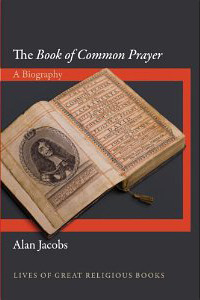Book Notes
 Alan Jacobs, The Book of Common Prayer, A Biography (Princeton: Princeton University Press, 2013), 236pp.
Alan Jacobs, The Book of Common Prayer, A Biography (Princeton: Princeton University Press, 2013), 236pp.
This volume is the newest installment in a series of twenty-one "biographies" of great religious books by Princeton University Press. The Lives of Great Religious Books is a "series of short volumes that recount the complex and fascinating histories of important religious texts from around the world" (dust jacket). The volumes pair leading experts with classic texts and are written for a general audience.
In earlier pages of Journey with Jesus, I've reviewed Augustine's Confessions (2011) by Garry Wills, Dietrich Bonhoeffer's Letters and Papers From Prison (2011) by Martin Marty, The Book of Mormon (2012) by Paul C. Gutjahr, and The Dead Sea Scrolls (2013) by John Collins. These are all fantastic books. Alan Jacobs maintains that high standard with his treatment of the Book of Common Prayer, which is a study that includes the roles of language, liturgy, history, politics, doctrine, and aesthetics.
Even those who've never heard of the BCP know some of its venerable language, like "I plight thee my troth" or "ashes to ashes, dust to dust." Such has been its cultural influence since publication in 1549. The book is primarily the work of Thomas Cranmer, Archbishop of Cantebury. It's a book that, written in the vernacular of ordinary believers, pulled the church out of 1000 years of an incomprehensible Latin liturgy. It was also a tool of socio-political control that intended to consolidate the rule of the English state over the English church. In some ways this happened — all over the world today believers still follow its liturgical lead, but in other ways, across three centuries of strife, that was always an elusive goal, or what Jacobs calls "a consoling fiction."
From the very beginning, the BCP had its defenders and detractors. Some thought its episcopal government and language about "altars" and "priests" was too papist, while others argued the opposite. Some loved the "set forms" for prayers and worship, while for others this was mindless repetition that institutionalized what should be deeply personal. For Dissenters and Non-Conformists, the BCP epitomized the church's entanglement with and coercion by the state. After 350 years, many find the venerable language off-putting. The BCP has been the subject of many revisions and riots. It has been banned and burned. Cranmer was burned to death in the streets of Oxford in 1556. Despite all the conflict and controversy, there are still many good reasons why the BCP is on Princeton's short list of one of the greatest religious texts ever.


